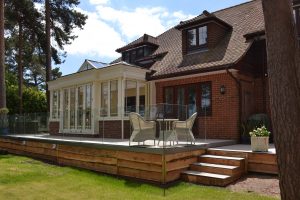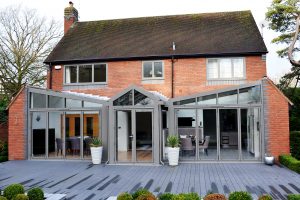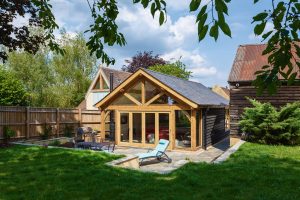Glass is the most wonderful material and has added a whole new dimension of what we can achieve by good design to home extensions. We can bring natural light in, open up the views to the garden and make small spaces seem much bigger. This all as the insulation of glass units has been greatly improved from the bad old days of single glazed units.
Glass is generally fitted in sealed double glazed units (DGU’s) This can be fitted to various frame material types. (See Materials) which of course gives a great choice of design ability. It is possible to get Triple Glazed units as well, and often clients will think this gives an automatic increase in insulation. It doesn’t.
All glass must be safely installed in accordance with BS6206 and BS6262. This defines areas of high risk where safety glass must be used. This also sets the maximum sheet size for thickness of glass.
Heat always flows from a hot side to a cold side. A cup of tea will cool down as the air around it is a lower temperature. So to keep the warm side at temperature it would need to have heat energy input. Heat passes in three different ways;
- Conduction, where heat passes through a fluid directly by heating the fluid through contact such as a kettle element heating water,
- Convection where heat is passed by moving the fluid adjacent to the glass as hot air rises,
- Radiation which is where heat passes directly through electromagnetic waves such as warming hands in front of a fire.
The way heat passes from the hot side to the cold side is really important to help see how enhanced and high performance glass units work. The better that a glass insulates and prevents heat loss makes for a much more comfortable, usable and energy efficient room. We talked a bit about insulation, U values, R values and heat loss here.


Every structure built must conform to building regulations. This sets acceptable minimum standards of performance for all elements of structure including Glass windows and doors. So, whatever we design must meet those minimum standards. Currently this is 1.6 W/m2K. For practical purposes as a single glazed unit is 6.0 W/m2K this means a minimum of a double glazed unit.
Increasing to a much higher performance DGU will pay big dividends. For instance increasing to a DGU with a U value of 1.0 W/m2K (remember – the LOWER the U value the LESS heat is lost) loses 63.2% less heat than building regulations compliant glass.
To get better performance, several things can change.
The gap between glass sheets can be maintained to an optimum. This doesn’t allow convection to build up. This is generally accepted as 16mm.
A coating can be put on the glass (soft coat) which interferes with the electromagnetic radiation. Better still it can also reflect the heat back into a room.
The gas used in the gap between glass sheets can be changed, It can be air, but Argon is a much better gas to use as it interrupts the Conduction and Convection of heat. Krypton gas provides better performance still.
Around the glass edges a “warm edge” bead can be used to seal the glass panels. The stops heat passage through conduction.
If sound reduction is a problem, acoustic glass can be incorporated to significantly reduce the sound transmittance. Sound reduction can also be achieved with a different thickness of glass on each side of the unit.
Glazing particularly on roofs and roof lanterns can be made “self cleaning” which really improves maintenance requirements. Also this can be made coated to shut out the excess sun’s energy passing through into the area.
Glass technology is moving on, and we have materials which are so much better performing, longer lasting and with a range of options that would have been unthinkable only a few years ago.
So what about Triple glazing? The technology is advancing. There are currently some systems available and sometimes they can give an improvement on insulation values. But not always. There is a down side – the overall thickness of the unit is typically 46 mm which can be quite bulky on many window units. Triple glazing is also heavy – it adds significantly to the weight of a unit in comparison to it’s double-glazed counterpart, and hence the structure to support it. And then there is the expense…
Currently it is generally better to use the best performing Double glazed unit which will give a U value every bit as good as all but the most advanced Triple glazed units. There are some continental systems which use triple glazing effectively – particularly in doors and metal windows – but systems are not quite there yet.





